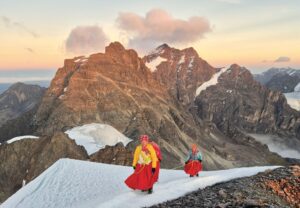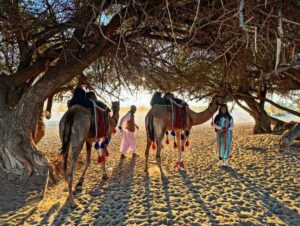The air is so thick that you can hardly breathe, and sweat from the heat and humidity coats you in seconds. Half the foliage wants to hold on to you, clawing at your clothes and hooking your limbs. You hack away at the green walls, progressing slowly while swatting ineffectually at clouds of insects intent on bleeding you dry. Tropical rainforests are brutal, but these rapidly shrinking worlds need protection. In Vietnam, the task falls to the Forest Rangers.

A Ranger disappears into the undergrowth of Cat Tien. Photo: Martin Walsh
Stationed in the jungle, far from their families, these hardy souls only rotate out on breaks for six days per month. Last year, I joined them for 10 days to see how they coped, and to shadow their efforts tracking two rehabilitated pygmy slow lorises — a type of small primate related to lemurs. Along the way, I gained some first-hand experience of the challenges of tropical expeditions.
I immediately discovered, for example, that I had arrived ill-equipped. My hiking shoes, a solid pair of Merrells, fell apart after three days. The soles detached completely in the heat, and they rapidly became waterlogged in the infernal dampness. They felt like sodden lead boots. The Ranger’s footwear surprised me, simple canvas lace-ups (think original Converse), but these fared much better. They were much lighter, dried quicker and could be cinched tightly around the ankles to keep out leeches.

Ranger Hoa takes a cigarette break, his smoke backlit by shafts of light through the forest canopy. Photo: Martin Walsh
I like most wildlife, but leeches are unquestionably hellspawn. During the rainy season, they march towards you from every direction as soon as you pause to catch your breath. They hang from leaves and drop on you from the canopy, they weevil their way through tiny holes in your defences. Leech socks and liberally applied repellent are therefore a must. Each morning we’d use toothbrushes to coat our shoes and socks. On my upper body, I found it best to go with a single long-sleeved shirt, tightly tucked into my trousers. Buttons were best avoided and a tight collar helped avoid unpleasant surprises.
An essential piece of kit was a machete. Fortunately, I was able to leave this tool in more experienced hands. Cutting your way through dense undergrowth is grueling work, but the Rangers of Nam Cat Tien in southern Vietnam are a tough bunch. Five Rangers live in the basic one-storey building that serves as the headquarters for this closed section of the national park.
There is no running water, and no respite day or night from the heat. It’s agonizingly consistent: Every day, the heat peaks at around 35ºC, and at night it drops off only slightly, bottoming out at a far from chilly 27ºC. Except for straight after the monsoon rain, when you get some momentary relief, the humidity is cloying and ever-present. There are no fans, just one solar-powered outlet and an occasional fleeting spot of phone signal relegated to a corner of the building.

A rare golden-cheeked gibbon. Photo: Martin Walsh
From this simple base, each Ranger is responsible for a designated area of the surrounding forest. They must protect their patch from illegal logging and poaching, while also rotating shifts to guard the only dirt track into the sector.
But they’re not only tasked with keeping people out of the forest, they also keep Vietnam’s last wild elephants in. This part of Cat Tien is closed for a reason. It’s estimated that between 20 and 50 wild Asian elephants have managed to survive here, in an increasingly isolated patch of forest. As their habitat has shrunk, conflicts with villagers have spiked. Elephants raid surrounding fruit farms, trample crops and occasionally kill villagers.
The Rangers have also found themselves in harm’s way. One was lucky to survive with only broken legs, after taking shelter in an irrigation ditch. Another fled a small herd of elephants, only to be gored by a forest buffalo, the fearfully butch-looking guar. The violence hasn’t been one way either: Villagers have allegedly poisoned and shot elephants over the past few years.
The government has set up an electrified fence to reduce these clashes, but it remains incomplete and some enterprising elephants have dug their way beneath the sections that work. For the Rangers, maintaining an effective perimeter only means that they are more likely to encounter elephants during their own patrols, since the few remaining pachyderms are packed into their seven hectares of responsibility.
I’m loathe to admit it, but the elephants are significantly more dangerous than the leeches. Just four days in, I had my first terrifying encounter. Deep in the forest, hoping for a radio-transmitter signal from one of the two incredibly elusive pygmy slow lorises, we had stopped to drink and to apply more insect repellent. A loud crash announced that we were not alone, quickly followed by a deep rumble and the sound of splintering bamboo.
We snatched up our belongings and ran headlong through the undergrowth away from the approaching noise. It was a frantic few minutes before we could rest. The Rangers suggested that the elephants had likely sniffed out the fruit-scented local repellent that we had been applying. Their curiosity could have been deadly.

The electric fence only stretches 1.5km in length. Photo: Martin Walsh
Perhaps an even bigger danger facing prospective jungle adventurers is navigation. The dense canopy and foliage make route-finding exceedingly difficult and thick clumps of bamboo often force detours. With no obvious landmarks and with direct-line travel almost impossible, an accurate and reliable GPS device is essential.
Jungle travel was significantly more taxing then I expected. I conceded defeat on the footwear front, binning my hiking shoes in favour of some fetching green canvas kicks. I left with a great deal of admiration for what the Forest Rangers are capable of withstanding, from six-hour slogs through the jungle to copious quantities of paint-stripper quality rice wine. These men somehow make living and working in the jungle look manageable. For me, 10 days was more than enough to send me scurrying back to colder climes.






